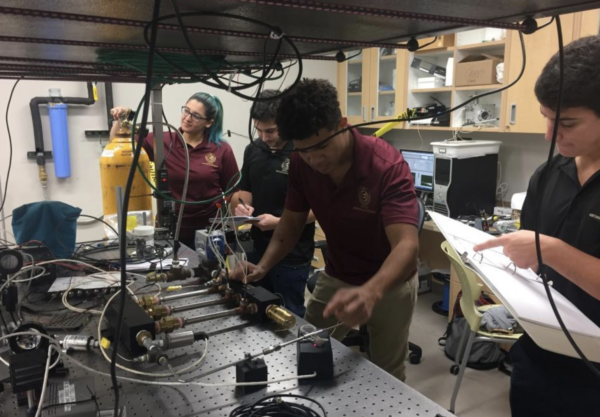Xenon Flow Controller – FAMU-FSU
INSTITUTIONS
Florida A&M University – Florida State University College of Engineering
Arizona State University (Tempe Campus)
Class
Iron Class (2018 – 2019)
Student TEAM
Zachary Barnes, Mechanical Engineering (FAMU-FSU)
Addison Iwanaga, Engineering Management (ASU)
Micaela Martinez, Electrical & Computer Engineering (FAMU-FSU)
James Quattrocchi, Electrical & Computer Engineering (FAMU-FSU)
Arturo San Segundo, Mechanical Engineering (FAMU-FSU)
Eric Smith, Mechanical Engineering (FAMU-FSU)
Scientific & Technical Guidance
Dr. Jason Frieman, NASA Glenn Research Center
Dr. Jim Martin, NASA Marshall Space Flight Center
Dr. Kurt Polzin, NASA Marshall Space Flight Center
Dr. Melissa Van Dyke, NASA Marshall Space Flight Center
Dr. Kenny Webster, NASA Marshall Space Flight Center
Academic Guidance
Dr. Jerris Hooker, Teaching Faculty, FAMU – FSU Electrical and Computer Engineering Department
Dr. Daniel McCarville, Professor of Practice, ASU School of Computing, Informatics, and Decision Systems Engineering
Dr. Shayne McConomy, Teaching Faculty, FAMU – FSU Mechanical Engineering Department
Project Description
NASA Psyche is a space exploration mission that will study an asteroid orbiting the sun between Mars and Jupiter. The Psyche spacecraft will collect data from this asteroid during a series of orbits. The spacecraft will reach and orbit the asteroid using a Hall-Effect Thruster. Hall-Effect Thrusters (HETs) generate thrust by utilizing ionized xenon gas. The thrust depends, in part, on the Xenon gas supplied to both the anode and cathode of the Hall-Effect Thruster. Therefore, a Xenon Flow Controller (XFC) is needed to precisely control xenon flow rates entering the Hall-Effect Thruster. The primary goal of this capstone project is to design, build, and test a Xenon Flow Controller (XFC) prototype that would supply a spacecraft with the fuel necessary to complete a similar mission. High-pressure containers aboard the spacecraft are used to store the xenon. The first stage of our XFC design will regulate the pressure down to workable levels. Our design includes a pressure management assembly used to achieve pressure control. Our XFC has two outlets connected to the anode and cathode of the HET. Two proportional flow control valves precisely control the mass flow entering the anode and cathode. Sensors record flow properties at two important locations within the XFC. Our XFC design uses the flow diagnostic data to correct any deviation from target flow rates. On a spacecraft, solar panels would be used to supply the XFC with power at a standard value, which would then be regulated to meet the needs of the controller. Our XFC prototype housing will also incorporate insulation layers to protect from the environment of space.


